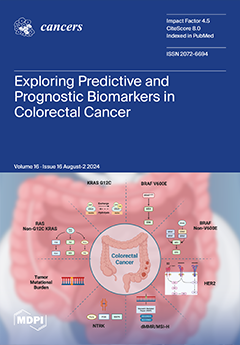The development of new, effective agents for the treatment of breast cancer remains a high-priority task in oncology. A strategy of treatment for this pathology depends significantly on the genotype and phenotype of human breast cancer cells. We aimed to investigate the antitumor activity of new pyrrolidinedione–thiazolidinone hybrid molecules
Les-6287,
Les-6294, and
Les-6328 towards different types of human breast cancer cells of MDA-MB-231, MCF-7, T-47D, and HCC1954 lines and murine breast cancer 4T1 cells by using the MTT, clonogenic and [
3H]-Thymidine incorporation assays, flow cytometry, ELISA, and qPCR. The studied hybrids possessed toxicity towards the mentioned tumor cells, with the IC
50 ranging from 1.37 to 21.85 µM. Simultaneously, these derivatives showed low toxicity towards the pseudonormal human breast epithelial cells of the MCF-10A line (IC
50 > 93.01 µM).
Les-6287 at 1 µM fully inhibited the formation of colonies of the MCF-7, MDA-MB-231, and HCC1954 cells, while
Les-6294 and
Les-6328 did that at 2.5 and 5 µM, respectively.
Les-6287 suppressed DNA biosynthesis in the MCF-7, MDA-MB-231, and HCC1954 cells. At the same time, such an effect on the MCF-10A cells was significantly lower.
Les-6287 induces apoptosis using extrinsic and intrinsic pathways via a decrease in the mitochondrial membrane potential, increasing the activity of caspases 3/7, 8, 9, and 10 in all immunohistochemically different human breast cancer cells.
Les-6287 decreased the concentration of the metastasis- and invasion-related proteins MMP-2, MMP-9, and ICAM-1. It did not induce autophagy in treated cells. In conclusion, the results of our study suggest that the synthesized hybrid pyrrolidinedione–thiazolidinones might be promising agents for treating breast tumors of different types.
Full article






